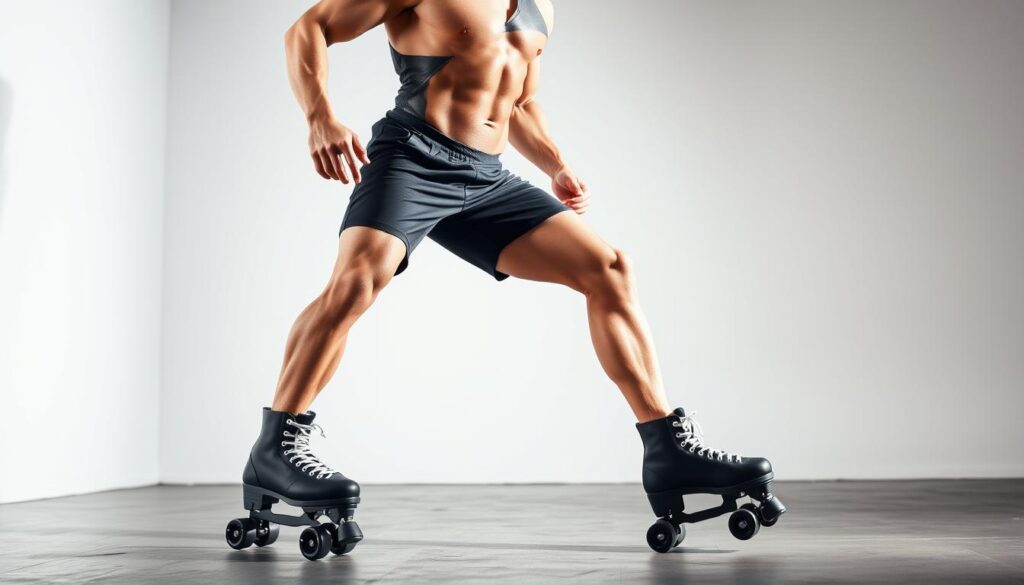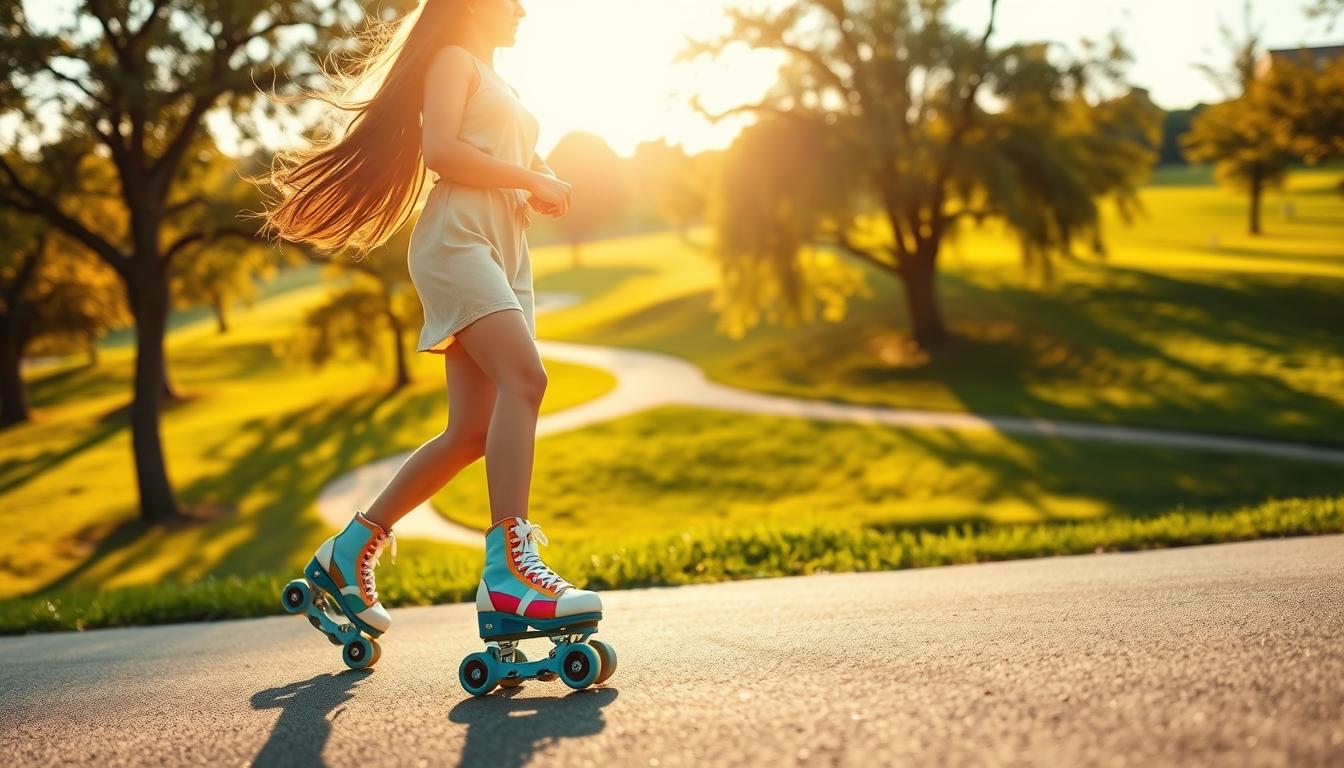Are you looking for a fun way to stay fit? Imagine gliding on wheels, feeling the wind in your hair, and enjoying the thrill of movement. Roller skating is an excellent way to get some exercise while having a blast. It’s a great workout and a fun activity for all ages.
Roller skating can improve your heart health, boost your mood, and make you feel better overall. This article will explore the benefits of roller skating for exercise. It will also give tips on how to get started.
Key Takeaways
- Roller skating is a fun and effective way to improve cardiovascular health.
- It can be enjoyed by people of all ages and skill levels.
- Regular roller skating can boost your mood and overall sense of well-being.
- It’s a great way to improve balance, coordination, and overall fitness.
- With the right equipment and safety precautions, anyone can get started.
The Resurgence of Roller Skating as a Fitness Trend
Roller skating is back as a fitness trend, thanks to its mix of fun and exercise. It’s not just a throwback; it’s a full-body workout.
Why Roller Skating is Making a Comeback
Roller skating is popular because it’s easy to do and good for you. It boosts heart health and strengthens muscles. Plus, it’s gentle on your joints, unlike running.
From Recreational Activity to Serious Workout
More people are turning to roller skating for a fun workout. It’s a challenge that keeps you moving and smiling. It’s a great way to stay fit and have fun.
Health Benefits of Roller Skating for Exercise
Roller skating offers many health benefits. It improves heart health and boosts mental well-being. This activity can greatly enhance your overall health.
Cardiovascular Improvements
Roller skating is a great cardio workout. It makes your heart work harder and improves blood flow. This can lower blood pressure and reduce heart disease risk.
Muscle Strengthening and Toning
It’s also a full-body strength training. Skating works your legs, glutes, and core. This leads to stronger and more toned muscles.
Balance and Coordination Enhancement
Roller skating also boosts balance and coordination. As you skate, you constantly adjust to stay balanced. This improves your physical coordination.
Mental Health Benefits
The mental health perks of roller skating are significant. The exercise releases endorphins, which lift your mood and reduce stress.
| Health Benefit | Description |
|---|---|
| Cardiovascular Improvements | Enhances heart health and circulation |
| Muscle Strengthening | Tones and strengthens muscles, mainly in the legs and core |
| Mental Health | Reduces stress and improves mood through endorphin release |
Calorie-Burning Ability of Roller Skating
Roller skating is a great way to burn calories. It’s fun and helps with weight management and fitness.
How Many Calories Can You Burn?
Roller skating is good for burning calories. A person can burn 400 to 600 calories per hour. For example, a 150-pound person can burn about 490 calories per hour.
Factors Affecting Calorie Burn
Several things affect how many calories you burn while roller skating. These include your weight, how fast you skate, and the terrain. Skating uphill or doing high-intensity intervals can burn more calories.
Comparing Calorie Burn to Other Activities
Roller skating is as effective as jogging or cycling in burning calories. Fitness experts say, “Roller skating is a great way to improve cardiovascular fitness while burning calories, making it an excellent alternative to traditional workouts.”
As fitness fans say,
“Roller skating is not just fun; it’s an effective workout that can help you achieve your fitness goals.”
Adding roller skating to your routine can be a fun way to stay active and healthy.
Essential Roller Skating Equipment for Fitness
The right equipment is key for a great roller skating experience. It boosts both safety and performance. Make sure to get the right gear for a fun and effective workout.
Choosing the Right Skates for Exercise
Choosing the right skates is critical for fitness skating. Look for skates that fit well, support your feet, and are made for fitness. Inline skates or quad skates work well, depending on your style. Make sure they have strong wheels and a sturdy frame for regular use.
Protective Gear You Shouldn’t Skip
Safety is the most important thing in roller skating. You need a helmet, knee pads, elbow pads, and wrist guards. These can greatly lower injury risk, even for beginners. Always wear protective gear, even if you’re sure you can skate well, because accidents can happen anytime.
Optional Accessories for Fitness Skating
There are extra accessories that can make skating better. You might want skate guards, comfy clothes, and hydration packs for longer skating. Some skaters also like skating socks or gloves for extra comfort and grip.
Maintenance Tips for Your Gear
To keep your gear in top shape, regular maintenance is essential. Clean your skates often and check for worn-out parts like wheels and bearings. Store your gear in a dry place, away from sunlight, and follow the maker’s care tips. Taking good care of your equipment means you can enjoy skating for a long time.
Safety Considerations Before You Start
Before you start skating, think about safety first. It’s not just about moving on wheels. It’s also about being careful and aware of your surroundings.
Proper Warm-Up Techniques
Warming up is key before you skate. It gets your muscles ready for the activity. Start with light cardio like jogging in place or jumping jacks. Then, do dynamic stretches for your legs, hips, and lower back.
Understanding Your Skating Environment
It’s important to know where you’re skating. Whether it’s indoors or outdoors, check the surface and any obstacles. Indoor rinks are smoother, but outdoors can have bumps and debris.
When to Consult a Doctor
If you’re new to skating or haven’t been active, see a doctor first. Some health issues might need special care or changes to your skating.
Common Injuries and Prevention
Skating can lead to sprains, fractures, and bruises. Wear helmets, knee pads, and elbow pads to protect yourself. Learning to fall safely is also key. Try to roll with the fall and avoid using your hands to break it, to prevent wrist injuries.
| Injury Type | Prevention Method |
|---|---|
| Sprains | Warm-up and stretching, proper skating technique |
| Fractures | Wearing protective gear, learning to fall correctly |
| Bruises | Protective gear, being aware of your surroundings |
Getting Started: Basic Roller Skating Techniques
Learning the basics of roller skating is key for a fun and safe time. You’ll want to focus on basic skills to feel more at ease on wheels.
Proper Stance and Balance
Stand with your feet shoulder-width apart, toes pointing slightly outward. Keep your knees bent and your weight centered over your feet. This stance helps you balance and prepares for movement. Practice standing before moving to get used to the skates and build confidence.
Forward Movement and Stopping
To move forward, push off with one foot and glide on the other. Alternate feet to keep moving. To stop, use the “T-stop” by dragging one foot across the other. Practice stopping and starting to control your speed.

Turning and Maneuvering
To turn, shift your weight onto one foot and push with the other. Lean into the turn to stay balanced. As you get more confident, try crossovers and other moves.
Building Confidence on Wheels
Practice is the best way to get better at roller skating. Start in a safe place like an empty rink or a smooth path. As you get more comfortable, try new things and mix up your skating. Engage your core and keep your center of gravity low to stay balanced.
Mastering these basics will help you enjoy roller skating. It’s a fun way to get fit, work your roller skating muscles, and boost your health.
Roller Skating for Exercise: Creating an Effective Workout Routine
Creating a good workout routine is key for getting the most out of roller skating for exercise. A well-planned routine boosts your fitness and keeps workouts fun and tough.
Structuring Your Skating Sessions
First, plan your skating sessions. Decide how often and long you’ll skate. Start with 2-3 times a week, for 30-45 minutes each. As you get better, you can skate more often and longer.
Incorporating Intervals and Challenges
Adding intervals and challenges to your roller skating workout increases calorie burn and heart health. Try alternating between steady skating and fast sprints.
| Workout Type | Duration | Intensity |
|---|---|---|
| Steady-State Skating | 20 minutes | Moderate |
| High-Intensity Sprints | 5 minutes | High |
| Cool Down | 5-10 minutes | Low |
Tracking Your Progress
It’s important to track your progress to stay motivated. Use a fitness tracker or a log to record your skating distance, time, and how you feel after each session.
Sample Weekly Skating Workout Plan
Here’s a sample plan: Monday (30 minutes, steady-state), Wednesday (45 minutes, interval training), and Friday (30 minutes, endurance skating). Adjust the plan as needed based on your progress and comfort level.
Muscles Worked During Roller Skating
Roller skating works out your whole body at once. It’s great for your heart and strengthens many muscles.
Lower Body Muscle Engagement
The main muscles used in roller skating are in your lower body. Quadriceps, hamstrings, glutes, and calf muscles get a workout as you move. Skating regularly can make these muscles stronger and more toned.
Core Activation While Skating
Your core muscles are key to staying balanced while skating. The abdominals and lower back muscles help you stay upright. They also aid in making turns and other moves.
Upper Body Involvement
Your upper body also gets a workout, mainly when you use your arms for balance or to push off. Shoulders, biceps, and triceps are used in different skating moves.
How Different Skating Styles Target Different Muscles
Various skating styles focus on different muscles. Aggressive skating, with its jumps and quick turns, works your legs and glutes hard. Slalom skating, on the other hand, targets your core and boosts agility.
Different Types of Roller Skating Workouts
Roller skating offers many workout options, from endurance skating to dance-based routines. This variety lets you pick a workout that fits your goals and likes.
Endurance Skating Sessions
Endurance skating means skating for a long time, usually 30 minutes or more. It’s great for your heart health and stamina. To get the most out of it, skate steadily and add interval training to burn more calories.
HIIT Skating Workouts
High-Intensity Interval Training (HIIT) on roller skates boosts your heart health and burns calories. It involves quick, intense skating followed by short breaks. It’s quick and can be tailored to your fitness level.

Rhythm and Dance Skating for Fitness
Rhythm and dance skating mixes fun dancing with roller skating’s benefits. You skate to music, do dance moves, and might learn routines. It’s a fun way to improve your coordination, balance, and fitness.
Trail and Outdoor Skating Adventures
Skating on trails and outdoors is a fun way to see new places while working out. It’s more challenging because of the terrain and weather. It’s a great way to boost your balance, strength, and agility.
Adding these roller skating workouts to your routine keeps it exciting and helps you reach your fitness goals.
Nutrition and Recovery for Roller Skating Fitness
Roller skating fitness is more than just the exercise. It’s also about how you fuel and recover your body. A well-nourished body can perform better and recover faster. This makes the most out of your roller skating workouts.
Fueling Your Body for Skating Workouts
To optimize your roller skating performance, eat a balanced diet. Include complex carbohydrates, lean proteins, and healthy fats. Complex carbs give you sustained energy. Lean proteins help with muscle repair and recovery.
Try whole-grain toast with avocado and eggs. It’s a great mix of complex carbs, healthy fats, and protein.
Hydration Before, During, and After Skating
Drinking enough water is key for maintaining performance and preventing dehydration. Drink water before, during, and after your skating sessions.
Drink at least 8-10 glasses of water a day. Adjust this based on how intense and long your skating is.
Recovery Techniques for Skaters
Good recovery techniques can greatly improve your roller skating experience. Use stretching, foam rolling, and adequate rest.
| Recovery Technique | Description | Benefits |
|---|---|---|
| Stretching | Focus on major muscle groups used in skating | Improved flexibility, reduced muscle soreness |
| Foam Rolling | Self-myofascial release to alleviate muscle tension | Enhanced recovery, reduced muscle knots |
| Adequate Rest | Ensure sufficient sleep and rest days | Muscle repair, overall physical and mental rejuvenation |
Balancing Skating with Other Forms of Exercise
Roller skating is great exercise, but mixing it with other activities is even better. It boosts your overall fitness and prevents injuries.
Add strength training and flexibility exercises to your routine. They complement your roller skating workouts well.
Progressing Your Roller Skating Fitness Journey
Want to take your roller skating to the next level? Learn new moves, up the intensity, and keep motivated. As you get better, it’s key to push yourself to keep improving.
Techniques to Boost Intensity
To up your roller skating game, add more complex moves to your routine. Try crossovers and power slides. These not only make your workout harder but also boost your skills.
Advanced Moves for Fitness Enhancement
Ready for more? Learn advanced techniques like agility drills and hill sprints. Agility drills help you speed up and turn quicker. Hill sprints build strength and endurance.
Setting and Achieving Skating Fitness Goals
Setting clear goals is vital for your roller skating journey. Aim to skate farther, faster, or master a new move. Make sure your goals are SMART to track your progress.
Joining Skating Communities for Motivation
Being part of a roller skating community can keep you motivated. Look for local clubs or skating buddies. They offer support, new techniques, and a sense of belonging.
Conclusion: Embracing Roller Skating as Your New Fitness Routine
Get Your Skates Here
Roller skating is a fun and effective way to get fit. It boosts your heart health, strengthens your legs, and lifts your mood. You’ll learn that it works many muscles, like your legs, glutes, and core.
Adding roller skating to your routine can really improve your balance and fitness. It’s perfect for those who want a low-impact or high-energy workout. Roller skating is both fun and active.
So, put on your skates and explore local rinks or trails. Roller skating is a great way to exercise and have fun. It’s perfect for anyone wanting to spice up their workout routine.

